-
 Bitcoin
Bitcoin $84,627.5051
1.14% -
 Ethereum
Ethereum $1,855.6441
-0.74% -
 Tether USDt
Tether USDt $1.0000
0.00% -
 XRP
XRP $2.1058
-1.79% -
 BNB
BNB $600.2230
-2.24% -
 Solana
Solana $125.6204
-1.58% -
 USDC
USDC $1.0001
-0.01% -
 Dogecoin
Dogecoin $0.1701
-0.66% -
 Cardano
Cardano $0.6784
0.34% -
 TRON
TRON $0.2371
0.60% -
 Toncoin
Toncoin $4.0172
-1.49% -
 Chainlink
Chainlink $13.4119
-4.28% -
 UNUS SED LEO
UNUS SED LEO $9.4376
1.38% -
 Stellar
Stellar $0.2662
-2.76% -
 Sui
Sui $2.4294
1.04% -
 Avalanche
Avalanche $19.0030
-2.37% -
 Shiba Inu
Shiba Inu $0.0...01234
-3.57% -
 Hedera
Hedera $0.1651
-2.70% -
 Polkadot
Polkadot $4.0598
-3.47% -
 Litecoin
Litecoin $82.5216
-2.40% -
 MANTRA
MANTRA $6.2876
0.21% -
 Bitcoin Cash
Bitcoin Cash $304.0026
-2.18% -
 Bitget Token
Bitget Token $4.5654
-0.87% -
 Dai
Dai $0.9998
-0.03% -
 Ethena USDe
Ethena USDe $0.9998
0.00% -
 Pi
Pi $0.6655
-5.50% -
 Hyperliquid
Hyperliquid $13.2989
-1.07% -
 Monero
Monero $215.5946
-0.70% -
 Uniswap
Uniswap $6.0237
-2.14% -
 Aptos
Aptos $5.2500
-1.97%
What does blockchain mining mean? What is the difference between GPU and ASIC mining?
Blockchain mining, crucial for cryptocurrencies like Bitcoin, involves solving complex problems to validate transactions and add them to the ledger, rewarding miners with new coins.
Apr 01, 2025 at 11:56 am
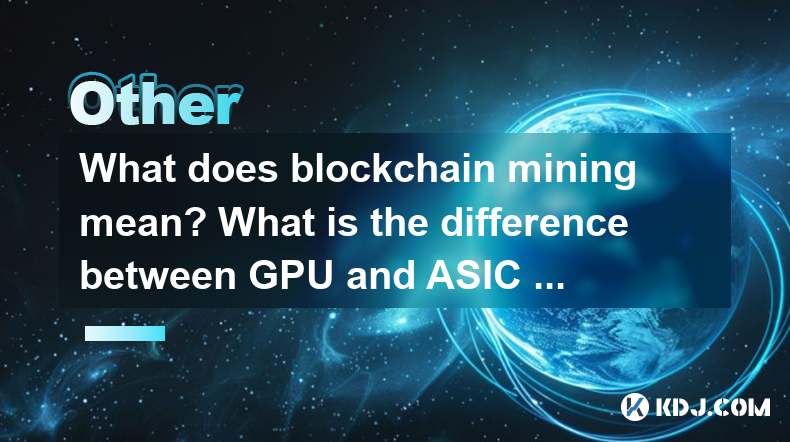
Blockchain mining is a crucial process in the world of cryptocurrencies, particularly for networks like Bitcoin and Ethereum. At its core, mining involves solving complex mathematical problems to validate transactions and add them to the blockchain, a decentralized ledger. Miners compete to solve these problems, and the first to succeed is rewarded with newly minted cryptocurrency and transaction fees. This process not only secures the network but also introduces new coins into circulation. The difficulty of these problems adjusts periodically to maintain a consistent block time, ensuring the network's stability and security.
The Role of Miners in the Blockchain Ecosystem
Miners play a vital role in maintaining the integrity and security of the blockchain. By validating transactions, they prevent double-spending and ensure that the ledger remains accurate and tamper-proof. Miners also contribute to the decentralization of the network, as anyone with the necessary hardware and software can participate. This democratic aspect is fundamental to the ethos of cryptocurrencies. Additionally, miners help to regulate the supply of cryptocurrencies, as the rewards they receive are programmed to decrease over time, mimicking the scarcity of commodities like gold.
How Does Blockchain Mining Work?
Blockchain mining involves several key steps that miners must follow to successfully add a block to the blockchain. First, miners collect a group of unconfirmed transactions from the network's memory pool. These transactions are then combined into a block, which includes a reference to the previous block, forming a chain. Miners then compete to find a solution to a cryptographic puzzle, which requires significant computational power. The solution, known as a "proof of work," is a hash that meets specific criteria set by the network. Once a miner finds a valid solution, they broadcast it to the network, and if verified, the block is added to the blockchain, and the miner is rewarded.
Types of Mining Hardware: GPU vs. ASIC
In the world of cryptocurrency mining, two primary types of hardware are used: Graphics Processing Units (GPUs) and Application-Specific Integrated Circuits (ASICs). GPUs are versatile pieces of hardware originally designed for rendering graphics in video games and other applications. They can be repurposed for mining due to their parallel processing capabilities, making them suitable for handling the complex calculations required in mining algorithms. On the other hand, ASICs are specialized hardware designed specifically for mining cryptocurrencies. They are more efficient and powerful than GPUs but are limited to mining specific algorithms.
Advantages and Disadvantages of GPU Mining
GPU mining has several advantages that make it appealing to many miners. One significant advantage is the versatility of GPUs. They can be used to mine a variety of cryptocurrencies, as they are not limited to specific algorithms. This flexibility allows miners to switch between different coins based on profitability. Additionally, GPUs are widely available and can be used for other purposes, such as gaming or professional graphics work, when not mining. However, GPU mining also has its drawbacks. It is less energy-efficient compared to ASIC mining, and the computational power of GPUs is generally lower, resulting in slower mining speeds and lower rewards.
Advantages and Disadvantages of ASIC Mining
ASIC mining offers several advantages that make it the preferred choice for many serious miners. The primary advantage is efficiency. ASICs are designed specifically for mining, which means they can perform the necessary calculations much faster and with less power consumption than GPUs. This efficiency translates into higher mining rewards and lower operational costs. However, ASIC mining also has its disadvantages. The most significant drawback is the lack of versatility. ASICs are designed for specific algorithms, meaning they can only mine certain cryptocurrencies. Additionally, ASICs are more expensive to purchase and can become obsolete if the cryptocurrency they are designed to mine changes its mining algorithm.
Comparing GPU and ASIC Mining: Key Differences
When comparing GPU and ASIC mining, several key differences stand out. GPU mining is more accessible and versatile, allowing miners to switch between different cryptocurrencies easily. GPUs are also more affordable and can be used for other purposes, making them a good choice for hobbyists and those new to mining. On the other hand, ASIC mining is more efficient and powerful, making it the preferred choice for professional miners looking to maximize their profits. However, ASICs are more expensive and less versatile, limiting their use to specific cryptocurrencies. Understanding these differences is crucial for miners deciding which type of hardware to invest in.
Energy Consumption and Environmental Impact
One of the most significant concerns surrounding blockchain mining is its energy consumption and environmental impact. Both GPU and ASIC mining require substantial amounts of electricity to operate, contributing to carbon emissions and environmental degradation. ASICs, while more energy-efficient per hash, often consume more power overall due to their higher computational power. Miners are increasingly looking for ways to mitigate these impacts, such as using renewable energy sources or participating in mining pools that prioritize sustainability. The environmental impact of mining is a critical consideration for the future of cryptocurrencies and the blockchain industry as a whole.
The Future of Mining: Trends and Innovations
The future of blockchain mining is likely to be shaped by several emerging trends and innovations. One significant trend is the shift towards more energy-efficient mining solutions. This includes the development of new ASIC designs that consume less power and the exploration of alternative consensus mechanisms, such as proof of stake, which do not require mining. Another trend is the increasing centralization of mining power, with large mining pools and companies dominating the industry. This has led to concerns about the decentralization of cryptocurrencies and efforts to create more decentralized mining solutions. Innovations in hardware and software are also driving the evolution of mining, with new technologies making it easier and more accessible for individuals to participate.
Choosing the Right Mining Hardware
Choosing the right mining hardware is a critical decision for any miner. Several factors need to be considered, including the type of cryptocurrency being mined, the initial cost of the hardware, its energy efficiency, and its potential resale value. For those interested in mining a variety of cryptocurrencies, GPUs may be the better choice due to their versatility. However, for those focused on mining a specific cryptocurrency, such as Bitcoin, ASICs may be more suitable due to their efficiency and higher mining rewards. It's also important to consider the long-term viability of the hardware, as mining algorithms and cryptocurrency values can change over time, affecting the profitability of mining operations.
The Economics of Mining: Profitability and Costs
The economics of mining are complex and influenced by several factors, including the price of the cryptocurrency being mined, the cost of electricity, and the efficiency of the mining hardware. Miners must carefully calculate their potential profits and costs to determine whether mining is a viable investment. The profitability of mining can fluctuate significantly, with changes in cryptocurrency prices and mining difficulty affecting the rewards miners receive. Additionally, the initial cost of purchasing mining hardware and the ongoing costs of electricity and maintenance must be considered. Miners often use mining calculators to estimate their potential profits and make informed decisions about their mining operations.
Mining Pools: Collaboration and Efficiency
Mining pools are a popular way for miners to collaborate and increase their chances of earning rewards. By pooling their computational resources, miners can solve cryptographic puzzles more quickly and share the rewards based on their contribution to the pool. Mining pools can be particularly beneficial for smaller miners who may not have the resources to mine independently. However, joining a mining pool also means sharing the rewards, which can reduce the individual miner's profits. Choosing the right mining pool involves considering factors such as the pool's fees, its reputation, and its payout structure. Mining pools play a crucial role in the mining ecosystem, helping to maintain the stability and security of the blockchain.
Regulatory and Legal Considerations
The regulatory and legal landscape surrounding blockchain mining is complex and varies by jurisdiction. Some countries have embraced mining, offering incentives and favorable regulations, while others have imposed restrictions or outright bans. Miners must be aware of the legal requirements in their area, including any necessary permits or licenses, and comply with tax obligations related to their mining activities. The regulatory environment can significantly impact the profitability and feasibility of mining operations. As the cryptocurrency industry continues to evolve, miners must stay informed about changes in regulations and adapt their operations accordingly to remain compliant and successful.
Common Questions and Answers
What is blockchain mining?
Blockchain mining is the process of validating transactions and adding them to the blockchain by solving complex mathematical problems. Miners compete to find a solution, and the first to succeed is rewarded with cryptocurrency.What is the difference between GPU and ASIC mining?
GPU mining uses versatile graphics processing units that can mine various cryptocurrencies but are less efficient. ASIC mining uses specialized hardware designed for specific algorithms, offering higher efficiency and mining speeds but less versatility.What are the advantages of GPU mining?
GPU mining is versatile, allowing miners to switch between different cryptocurrencies. GPUs are also more affordable and can be used for other purposes, such as gaming.What are the advantages of ASIC mining?
ASIC mining is more efficient and powerful, resulting in higher mining rewards and lower operational costs. However, ASICs are more expensive and limited to specific algorithms.How does mining impact the environment?
Mining consumes significant amounts of electricity, contributing to carbon emissions. Miners are exploring renewable energy sources and more energy-efficient solutions to mitigate these impacts.What are mining pools, and why are they important?
Mining pools allow miners to collaborate and increase their chances of earning rewards by pooling their computational resources. They are important for smaller miners and help maintain the stability and security of the blockchain.What factors should be considered when choosing mining hardware?
Factors to consider include the type of cryptocurrency being mined, the initial cost of the hardware, its energy efficiency, and its potential resale value. The choice between GPUs and ASICs depends on the miner's goals and resources.How do regulatory and legal considerations affect mining?
Regulatory and legal considerations vary by jurisdiction and can impact the profitability and feasibility of mining operations. Miners must comply with local regulations and stay informed about changes in the legal landscape.
Disclaimer:info@kdj.com
The information provided is not trading advice. kdj.com does not assume any responsibility for any investments made based on the information provided in this article. Cryptocurrencies are highly volatile and it is highly recommended that you invest with caution after thorough research!
If you believe that the content used on this website infringes your copyright, please contact us immediately (info@kdj.com) and we will delete it promptly.
- Trump's Tariff Liberation Day Is Here, and Investors Are Making Cautious Moves
- 2025-04-02 21:45:12
- Bitcoin is back in the spotlight – and not just because of the price charts.
- 2025-04-02 21:45:12
- Tether Doubles Down on Bitcoin, Adding 8888 BTC to its Reserves in Q1 2025
- 2025-04-02 21:40:12
- Binance Coin (BNB) Hovers Near the $600 Mark as Bearish Technical Indicators Suggest a Potential Dip Below $580
- 2025-04-02 21:40:12
- Is a Bitcoin Price rebound coming?
- 2025-04-02 21:35:12
- XRP Price Prediction: EGRAG Crypto Anticipates XRP to Develop a Major Price Breakout
- 2025-04-02 21:35:12
Related knowledge
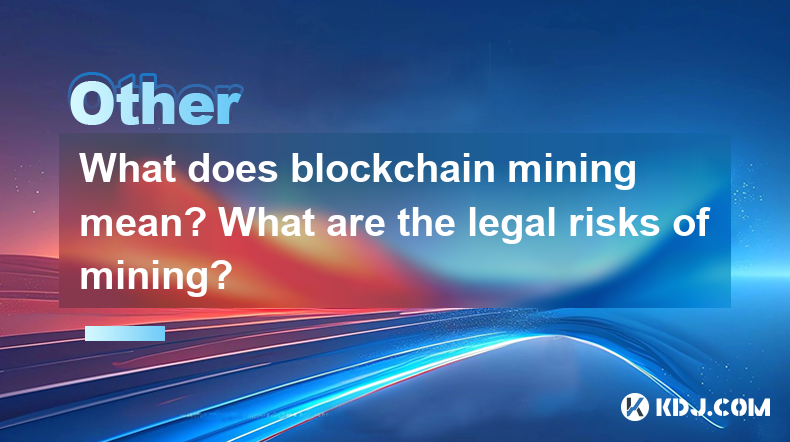
What does blockchain mining mean? What are the legal risks of mining?
Mar 31,2025 at 05:07pm
Blockchain mining is the process by which transactions are verified and added to the public ledger, known as the blockchain. Miners use powerful computers to solve complex mathematical problems, which, once solved, allow them to add a block of transactions to the blockchain. In return, miners are rewarded with cryptocurrency, typically Bitcoin. This pro...
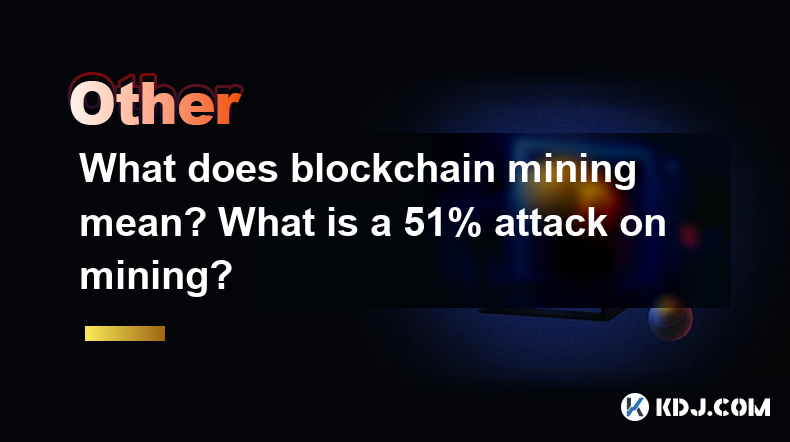
What does blockchain mining mean? What is a 51% attack on mining?
Apr 02,2025 at 03:28am
Blockchain mining is a critical process in the world of cryptocurrencies, particularly those that use proof-of-work (PoW) consensus mechanisms like Bitcoin. Mining involves using computational power to solve complex mathematical puzzles, which, when solved, validate and add new transactions to the blockchain. Miners are incentivized to participate throu...
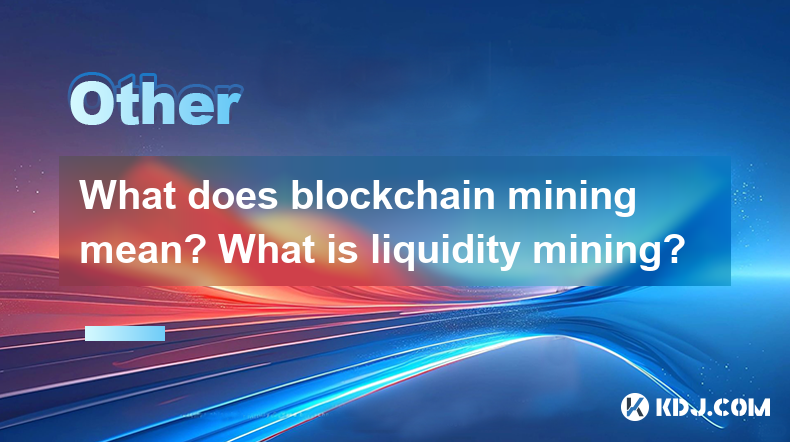
What does blockchain mining mean? What is liquidity mining?
Apr 01,2025 at 12:07am
What is Blockchain Mining?Blockchain mining is a critical process in the world of cryptocurrencies, particularly for networks like Bitcoin and Ethereum. It involves the use of computational power to solve complex mathematical problems, which in turn validates transactions and adds them to the blockchain. Miners are incentivized through rewards, typicall...
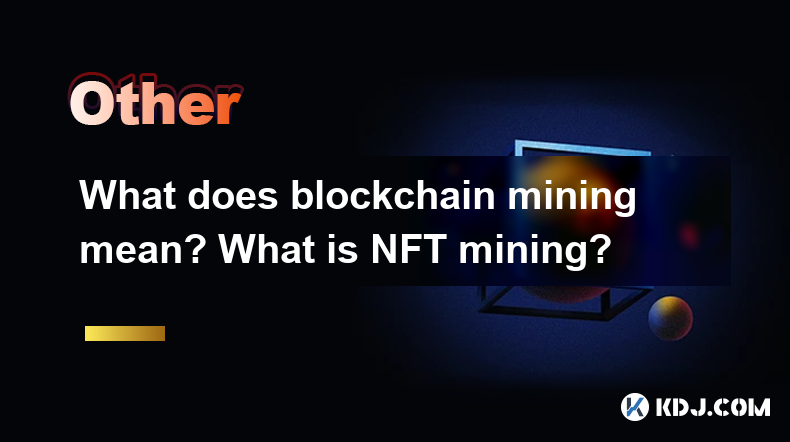
What does blockchain mining mean? What is NFT mining?
Mar 31,2025 at 04:07pm
Blockchain mining is a crucial process in the world of cryptocurrencies, particularly for networks like Bitcoin and Ethereum. It involves verifying transactions and adding them to the blockchain, a decentralized ledger. Miners use powerful computers to solve complex mathematical problems, which, when solved, allow them to add a block of transactions to ...

What does blockchain mining mean? What is the difference between cold wallets and hot wallets for mining?
Apr 01,2025 at 07:56am
Blockchain mining is a critical process in the world of cryptocurrencies. It involves verifying transactions and adding them to the blockchain, a decentralized ledger. Miners use powerful computers to solve complex mathematical problems, which, when solved, allow them to add a block of transactions to the blockchain. In return, miners are rewarded with ...

What does blockchain mining mean? What is the difference between GPU and ASIC mining?
Apr 01,2025 at 11:56am
Blockchain mining is a crucial process in the world of cryptocurrencies, particularly for networks like Bitcoin and Ethereum. At its core, mining involves solving complex mathematical problems to validate transactions and add them to the blockchain, a decentralized ledger. Miners compete to solve these problems, and the first to succeed is rewarded with...

What does blockchain mining mean? What are the legal risks of mining?
Mar 31,2025 at 05:07pm
Blockchain mining is the process by which transactions are verified and added to the public ledger, known as the blockchain. Miners use powerful computers to solve complex mathematical problems, which, once solved, allow them to add a block of transactions to the blockchain. In return, miners are rewarded with cryptocurrency, typically Bitcoin. This pro...

What does blockchain mining mean? What is a 51% attack on mining?
Apr 02,2025 at 03:28am
Blockchain mining is a critical process in the world of cryptocurrencies, particularly those that use proof-of-work (PoW) consensus mechanisms like Bitcoin. Mining involves using computational power to solve complex mathematical puzzles, which, when solved, validate and add new transactions to the blockchain. Miners are incentivized to participate throu...

What does blockchain mining mean? What is liquidity mining?
Apr 01,2025 at 12:07am
What is Blockchain Mining?Blockchain mining is a critical process in the world of cryptocurrencies, particularly for networks like Bitcoin and Ethereum. It involves the use of computational power to solve complex mathematical problems, which in turn validates transactions and adds them to the blockchain. Miners are incentivized through rewards, typicall...

What does blockchain mining mean? What is NFT mining?
Mar 31,2025 at 04:07pm
Blockchain mining is a crucial process in the world of cryptocurrencies, particularly for networks like Bitcoin and Ethereum. It involves verifying transactions and adding them to the blockchain, a decentralized ledger. Miners use powerful computers to solve complex mathematical problems, which, when solved, allow them to add a block of transactions to ...

What does blockchain mining mean? What is the difference between cold wallets and hot wallets for mining?
Apr 01,2025 at 07:56am
Blockchain mining is a critical process in the world of cryptocurrencies. It involves verifying transactions and adding them to the blockchain, a decentralized ledger. Miners use powerful computers to solve complex mathematical problems, which, when solved, allow them to add a block of transactions to the blockchain. In return, miners are rewarded with ...

What does blockchain mining mean? What is the difference between GPU and ASIC mining?
Apr 01,2025 at 11:56am
Blockchain mining is a crucial process in the world of cryptocurrencies, particularly for networks like Bitcoin and Ethereum. At its core, mining involves solving complex mathematical problems to validate transactions and add them to the blockchain, a decentralized ledger. Miners compete to solve these problems, and the first to succeed is rewarded with...
See all articles

























































































